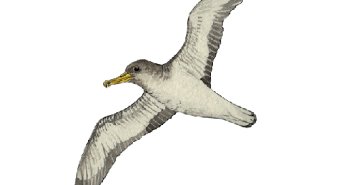
Cory’s shearwater
(Calonectris borealis)
Cory’s shearwaters (in the family Procellariidae) spend their lives almost entirely at sea. It is a pelagic seabird, that only returns to land to breed. It belongs to the order of tubenoses, a taxonomic group that also includes albatrosses and storm petrels.
Tubenoses were named after the two tubular nasal passages on their long,hooked beak, through which they can excrete salt.
Some species can even spray an oily liquid from these tubes at approaching attackers. The three front toes of these birds are webbed.
Cory’s shearwaters like all other tubenoses are best adapted to long-distance flight and are able to cover huge distances and endure severe storms.
This seabird can be seen in Madeira during the breeding season between March and October.
General information
Further names: Portuguese: Cagarra
Prey: They mainly feed on fish and squids; also invertebrates and crustaceans.
Range: Globally present; seas and oceans in all climate zones.
Distinctive features: Greyish-brown on the back; pale belly and pale markings on the underside of the wings; slightly rounded, long wings; yellowish beak with a dark ring at the tip.
Size of adult animals: At a length of 46 to 60 cm and a wingspan of 112 to 126 cm, Cory’s shearwaters are the largest of the seabirds nesting in Madeira.
Ecology: These birds nest in colonies, mostly in rock caves and crevices in cliff faces. One clutch a year consisting of a single egg (May, June). These birds are monogamous and always attempt to pair up with the same mate from the previous breeding season and also prefer returning to the same nesting colony as the previous year. The incubation period is 51 to 61 days. Chicks hatch complete with downy plumage and have a relatively slow growth, leaving the nest only after two to nine months. At the beginning, one parent bird is constantly with the chick until the young animal reaches a certain size, demanding both parent birds to leave the nest in search for food. When feeding, the parent bird grabs the beak of the chick at a right angle and regurgitates its prey to feed the chick. During the breeding season, the vocalisations of the parent birds can be easily heard within a short distance from the nesting sites. In flight, they give out a loud, wailing call. The worldwide biggest colony of Cory’s shearwaters consisting of approx. 13,600 breeding pairs can be found in the uninhabited Savage Islands halfway between Madeira and the Canaries to the South. There, they also nest on the ground (in burrows). They are long-lived and very vocal birds that are very social, often even forming rafts at sea.
Taxonomy: Class: Aves (Birds); Order: Procellariiformes (Tubenoses)
Threats: In the past this species was exploited leading to significant decreases in their populations. Today invasive species such as rats, cats and livestock present the greatest threat along with light pollution.
